
Archips oporana, also known as the pine tortrix or spruce tortrix is a moth of the family Tortricidae, found in Asia and Europe. It was first described by Carl Linnaeus in 1758.

Archips podana, the large fruit-tree tortrix, is a moth of the family Tortricidae. The species was first described by Giovanni Antonio Scopoli in his 1763 Entomologia Carniolica. It is found in Europe, Asia from Anatolia to Japan and is an introduced species in North America.

Epinotia nanana, the European spruce needleminer, is a moth of the family Tortricidae. It is found from northern and central Europe to Russia and Mongolia.

Epinotia pygmaeana, the pygmy needle tortricid, is a moth of the family Tortricidae. It is found across the Palearctic from northern and central Europe to eastern Russia.

Taniva is a monotypic moth genus belonging to the family Tortricidae erected by Carl Heinrich in 1926. Its only species, Taniva albolineana, the spruce needleminer moth, was first described by William D. Kearfott in 1907.

Archips negundana, the larger boxelder leafroller, is a moth of the family Tortricidae. The species was first described by Harrison Gray Dyar Jr. in 1902. It is found in North America from southern British Columbia to southern Quebec, south to California and Florida.
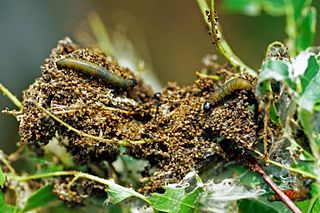
Archips fervidana, the oak webworm moth, is a moth of the family Tortricidae. It is found from Maine and Quebec to North Carolina, west to Wisconsin and Arkansas.
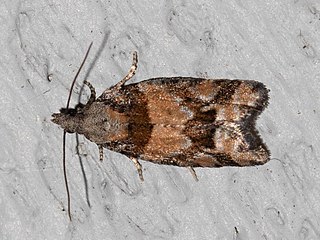
Epinotia radicana, the red-striped needleworm moth, is a species of moth of the family Tortricidae. It is found in western Canada, including British Columbia and Alberta.
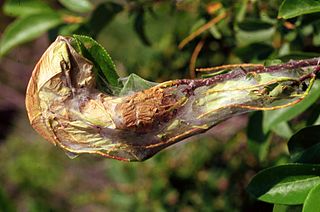
Archips cerasivorana, the ugly-nest caterpillar moth, is a species of moth of the family Tortricidae. The caterpillars of this species are known to create nests by tying the leaves of their host plant together. Within the nests, they live and feed off the leaves that have been tied together. The larvae are brownish or greenish yellow with a shiny dark brown head. Larvae can be found from May to July. The species overwinters as an egg, and pupation takes place within the nest. Caterpillars are seen to follow one another in trails, a behavior prompted by the release of signaling pheromones from their spinnerets.
Anopina arizonana is a moth of the family Tortricidae first described by Lord Walsingham in 1884. It is found in North America from southern interior British Columbia and from Waterton Lakes, Alberta, south to Arizona.
Archepandemis coniferana is a species of moth of the family Tortricidae first described by Akira Mutuura in 1978. It is found in North America, where it has been recorded from Alberta, British Columbia and California. The habitat consists of coniferous forests.
Archips fumosus is a species of moth of the family Tortricidae. It is found in Russia, China and Japan.
Archips crassifolianus is a species of moth of the family Tortricidae. It is found in Gansu, China.
Archips eleagnanus is a species of moth of the family Tortricidae first described by James Halliday McDunnough in 1923. It is found in North America, where it has been recorded from Alberta, Manitoba, Saskatchewan, Wyoming and New Mexico. The habitat consists of prairies and montane areas.
Archips dissitanus, the boldly-marked archips moth, is a species of moth of the family Tortricidae. It is found in North America, where it has been recorded from Alberta to Nova Scotia and south to Minnesota and North Carolina in the Appalachian Mountains. The habitat consists of boreal forests.
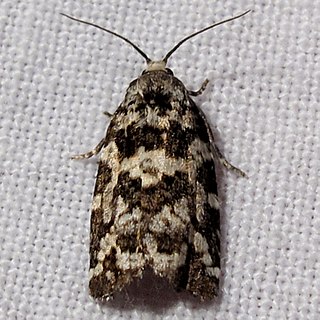
Archips packardianus, the spring spruce needle moth or spruce needleworm, is a species of moth of the family Tortricidae. Spruce needle worms are commonly found in small numbers on spruce and trees of other coniferous genera throughout most of Canada and the northeastern US. Archips packardiana overwinters as a tiny larva in a mined needle. Needle mining is resumed in the spring, the larvae later moving to feed on new foliage, where they spin considerable webbing. Full-grown larvae have a pale green head, sometimes patterned with brown, and a pale body and pale thoracic legs, and are about 20 mm long. The larva pupates, usually in the webbed needles, and the adult emerges in summer to early fall. The closely related Archips strianus is much less common, but probably has a habitat similar to that of A. packardiana. The larvae have dark thoracic legs and small dark areas around the base of the thoracic hairs. The habitat consists of coniferous and mixed woods.
Argyrotaenia occultana, the fall spruce needle moth, is a moth of the family Tortricidae. The species was first described by Thomas Nesbitt Freeman in 1942. It is found in North America, where it has been recorded from British Columbia north to Yukon and Northwest Territories, east to Newfoundland and south to Kentucky and Oregon. The habitat consists of spruce forests.
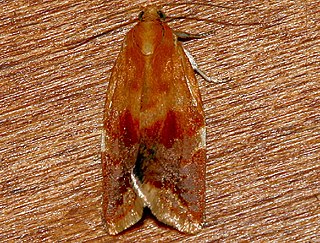
Clepsis persicana, the white triangle tortrix or the green needleworm, is a species of moth of the family Tortricidae. It is found in North America, where it has been recorded from Alaska and British Columbia to Newfoundland and south to Virginia and west to California. The habitat consists of coniferous and mixed coniferous forests.

Syndemis afflictana, the gray leafroller, dead leaf roller or black-and-gray banded leafroller, is a species of moth of the family Tortricidae. It is found in North America, where it has been recorded from southern Canada and the northern United States. In the west, the range extends south in the mountains to California. The species is also present in Florida. The habitat consists of coniferous forests.
Coleotechnites ducharmei is a moth of the family Gelechiidae. It is found in North America, where it has been recorded in south-western Nova Scotia, southern Quebec, Ontario, and Alberta.











